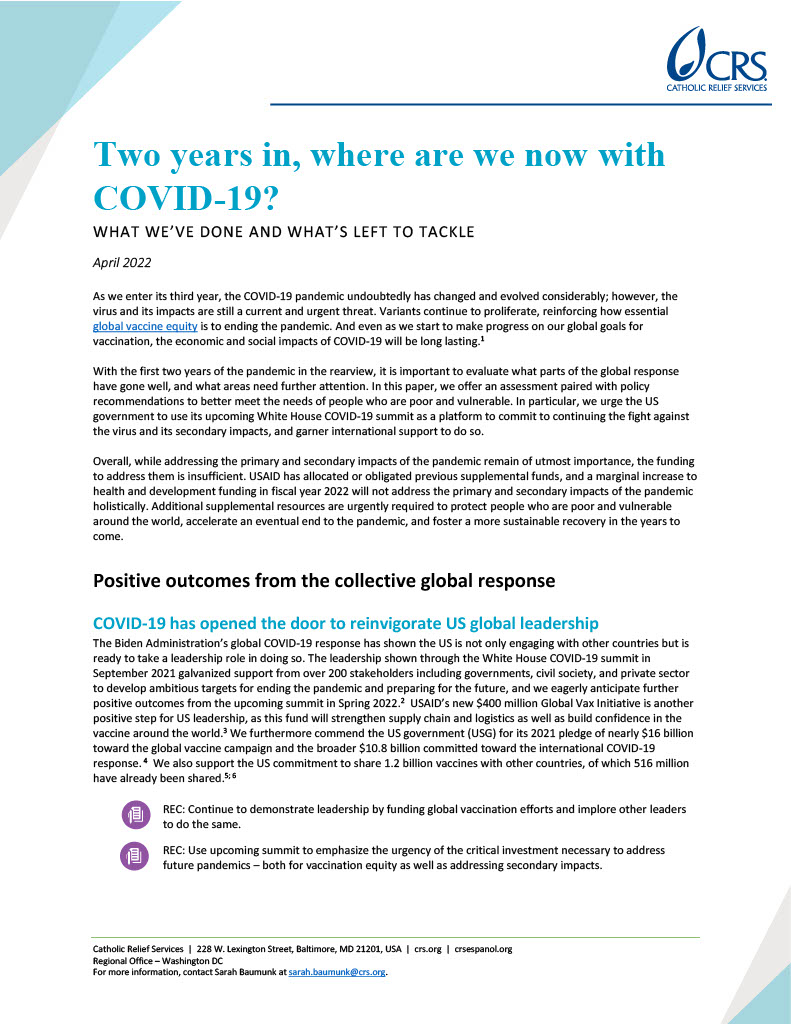
Two years in, where are we now with COVID-19?
Introduction
As we enter its third year, the COVID-19 pandemic undoubtedly has changed and evolved considerably; however, the virus and its impacts are still a current and urgent threat. Variants continue to proliferate, reinforcing how essential global vaccine equity is to ending the pandemic. And even as we start to make progress on our global goals for vaccination, the economic and social impacts of COVID-19 will be long lasting.
With the first two years of the pandemic in the rearview, it is important to evaluate what parts of the global response have gone well, and what areas need further attention. In this paper, we offer an assessment paired with policy recommendations to better meet the needs of people who are poor and vulnerable. In particular, we urge the US government to use its upcoming White House COVID-19 summit as a platform to commit to continuing the fight against the virus and its secondary impacts, and garner international support to do so.
Overall, while addressing the primary and secondary impacts of the pandemic remain of utmost importance, the funding to address them is insufficient. USAID has allocated or obligated previous supplemental funds, and a marginal increase to health and development funding in fiscal year 2022 will not address the primary and secondary impacts of the pandemic holistically. Additional supplemental resources are urgently required to protect people who are poor and vulnerable around the world, accelerate an eventual end to the pandemic, and foster a more sustainable recovery in the years to come.
This report draws on data derived from qualitative interviews, focus group discussions (FGDs), and a quantitative survey — the CRS Social Cohesion Barometer — conducted in six locations across three countries to assess the impact of the COVID-19 pandemic on social cohesion dynamics. In total, 84 key informant interviews (KIIs) and 38 FGDs were conducted for a total of 312 participants. The report assesses the impact of the pandemic, and governments’ responses to it, along both horizontal and vertical dimensions of social cohesion. It also highlights the role and community perceptions of civil society actors involved in this response. In doing so, the report draws conclusions and recommendations to support social cohesion efforts in these, and other communities.
Positive outcomes from the collective global response:
- COVID-19 has opened the door to reinvigorate US global leadership
- Global poverty is increasing, but investments in social safety nets have proliferated
- Global cooperation has made strides, but we need more political will to achieve vaccine equity
-
A new vision of localization has evolved, optimizing the utilization of existing networks
-
The importance of public health systems is renewed
Areas needing greater attention:
- Educational Gains have been lost and continue to widen
-
Devastating loss of millions of caregivers
-
Rising hunger means we are no longer on track to meet Zero Hunger by 2030
-
Social ties of people to each other and to the state have broken down significantly
Published April 2022


